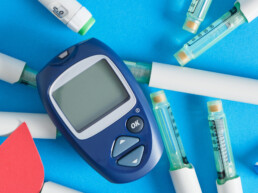Introduction
India is facing a serious health crisis: 32.8% of the population now has Prediabetes . Yet, many people don’t realise they might already show some early signs. Without timely intervention, Prediabetes can progress to Type 2 Diabetes, bringing along serious health risks. Here’s what you should know about Prediabetes, why it’s becoming so common, and the early signs that can prompt you to take action.
What is Prediabetes?
Prediabetes is a condition where blood sugar levels are elevated but not yet high enough to be classified as Type 2 Diabetes. This often happens due to insulin resistance , meaning the body’s cells don’t respond as they should to insulin, the hormone responsible for managing blood sugar levels. This resistance causes blood sugar to build up in the bloodstream, setting the stage for Type 2 Diabetes if it goes unchecked.
The Indian Prediabetes Epidemic
Why is Prediabetes rising so rapidly in India? The 32.8% prevalence rate (1) is startling. A combination of modern lifestyle shifts, such as more sedentary behaviour, high-carbohydrate diets, and elevated stress levels , is fueling this issue. Key contributing factors include:
• Dietary Patterns: Traditional Indian diets are rich in carbohydrates and refined grains. While foods like rice and chapati are staples, consuming too many carbs without balancing them with protein and fibre can cause blood sugar spikes.
• Urban Lifestyles: In cities, long work hours, high stress, and limited physical activity increase the risk. Quick, processed food choices often become convenient, which can worsen insulin resistance .
• Sleep Disruption: High-stress lifestyles and irregular work hours in India often disrupt sleep quality (5). This can increase insulin resistance and result in heightened hunger the following day, both of which affect blood sugar levels.
• Lack of Awareness: Prediabetes isn’t limited to people with weight concerns; it can affect anyone. Many people remain unaware of their risk, delaying early diagnosis and intervention.
This epidemic continues to grow partly because early signs are easy to overlook. Recognising these signs early can help you take steps to prevent or even reverse Prediabetes.

Early Signs of Prediabetes
Do any of these signs sound familiar to you? Recognising them early could be the key to taking action before Prediabetes progresses. Here are some symptoms to look out for:
• Frequent Hunger: Do you often find yourself hungry, even shortly after a meal? Insulin resistance can make your cells feel starved for energy, leading to a constant urge to eat. This isn’t just about feeling peckish—it could be a signal your body’s trying to send you.
• Fatigue: Feeling tired even when you’re getting enough rest? This isn’t just “life” or “getting older.” When glucose can’t enter your cells efficiently your body is left without the fuel it needs to keep you energised, leaving you feeling drained more often than not.
• Increased Thirst and Urination: Have you noticed you’re thirstier than usual or making more trips to the bathroom? High blood sugar draws water from your tissues, which can lead to dehydration and frequent urination. These might seem like small changes, but together they’re worth paying attention to.
• Darkened Skin Patches (Acanthosis Nigricans): Ever spotted dark, velvety patches on your neck or armpits? These areas of skin could be telling you that your insulin levels are high (2)—a common early sign of insulin resistance.
• BMI and Waist Circumference: For people of Asian descent, a healthy BMI is between 18.5 and 22.9; a BMI above 23 may indicate increased risk However, even with a normal BMI, an increased waist circumference—over 90 cm for men and 80 cm for women—can signal risk. Excess abdominal, or visceral fat, contributes to a larger waistline and is strongly linked to insulin resistance and blood sugar issues, making it an important early sign of Prediabetes.
If any of these symptoms sound familiar, especially if you notice more than one, it might be time to check in with your health. Prediabetes symptoms can often go unnoticed, so a little awareness now could make all the difference.
How is Prediabetes Diagnosed?
The following tests are commonly used to assess blood sugar levels and detect Prediabetes :
• Fasting Blood Glucose Test: Measures blood sugar after an overnight fast. Elevated levels can indicate Prediabetes.
• HbA1c Test: Provides an average blood sugar reading over the past two to three months.
• Oral Glucose Tolerance Test (OGTT): Measures blood sugar before and after consuming a glucose solution.
Where Health Meets Opportunity
With almost a third of Indians affected by Prediabetes, recognising early signs gives you a unique chance to take action. These signs are more than just warnings; they’re reminders to reassess your daily habits before complications arise. Small, targeted changes can help prevent Prediabetes from advancing, guiding you to detect Prediabetes early and take steps that protect your long-term health.
SHARE

Madhavi Shilpi
Nutritionist
Prediabetes Coach
Related
Why Early Diagnosis of Prediabetes Is Key to Preventing Type 2 Diabetes
Introduction Imagine this: you’re feeling pretty healthy. Maybe you’re a…
How Modern Indian Diets Are Quietly Fuelling Insulin Resistance and Prediabetes
In today’s fast-paced world, the Indian diet is evolving to match modern…
Proteins: Building Blocks for a Stronger You
Are you curious about the role proteins play in our diet? Do you wonder…
Carbohydrates: Fuel For Your Body
Do you often wonder about the role carbohydrates play in our diet? Did…
Fats: A Balanced Perspective
Fats are good for us. Fats are bad for us. The argument rages on. Is there a…
Insulin Resistance: symptoms, causes & more
Insulin resistance (IR) is a condition in which the body's cells do not…
What is Prediabetes?
Have you been diagnosed with Prediabetes? Are you wondering what it actually…







